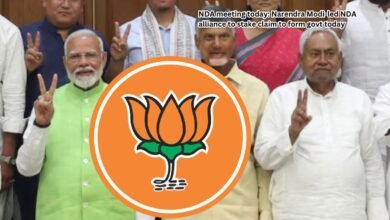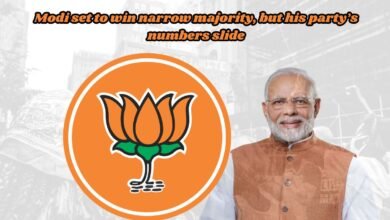‘Still a strong story.’ Why India’s election shock won’t derail its economic boom
India's election surprise won't halt its economic growth. Despite election shock, the nation remains on track for a strong economic narrative.

India’s election shock won’t derail its economic boom – a strong narrative persists despite political shifts, fostering resilience. The recent election results in India have sent ripples through the political landscape, catching many analysts and citizens by surprise.
The unexpected outcomes have significantly altered the balance of power, with major parties experiencing unforeseen shifts in their fortunes. This election saw the ruling party, which was widely anticipated to secure a decisive victory, facing an unexpectedly strong challenge from the opposition.
The dominant party’s reduced majority and the impressive performance of smaller regional parties have reshaped the political dynamics.
Key players in this election included the incumbent Bharatiya Janata Party (BJP) and the Indian National Congress (INC), alongside various regional parties that have gained increased influence. The BJP, led by Prime Minister Narendra Modi, was expected to capitalize on its previous successes and strong economic policies.
However, the INC, led by Rahul Gandhi, managed to galvanize significant support, highlighting issues such as unemployment and agrarian distress. Additionally, regional parties like the Trinamool Congress in West Bengal and the Dravida Munnetra Kazhagam in Tamil Nadu have emerged as formidable forces, further complicating the national political equation.
This election was particularly impactful due to the high stakes involved. It was seen as a referendum on the BJP’s economic and social policies over the past few years. The unexpected results have led to a period of political uncertainty, raising concerns about policy continuity and governance stability.
Domestically, there were initial worries about potential disruptions in economic reforms and investment inflows. Internationally, observers have been keenly monitoring the developments, given India’s significant role in the global economy. The election shock has prompted discussions about the resilience of India’s democratic fabric and its implications for future governance.
India’s Economic Resilience
India’s economy demonstrates remarkable resilience, buoyed by several intrinsic strengths that position it to weather political uncertainties effectively. One of the foremost contributors to this resilience is the nation’s demographic dividend. With a youthful population, India enjoys a vast labor force ready to drive economic growth and innovation. This demographic advantage is complemented by a burgeoning middle class, which fuels consumption and supports a thriving domestic market.
The robust service sector is another pillar of India’s economic strength. The IT and IT-enabled services (ITES) sector, in particular, has established India as a global hub for outsourcing and technology services. This sector not only generates significant revenue but also attracts substantial foreign investments, bolstering economic stability. According to the National Association of Software and Service Companies (NASSCOM), India’s IT industry is expected to reach $350 billion by 2025, underscoring its pivotal role in the economy.
Economic indicators paint a promising picture of India’s growth trajectory. The country’s GDP growth rate, which has averaged around 7% over the past decade, signifies robust economic health. Foreign direct investment (FDI) inflows have been steadily increasing, reaching $81.72 billion in the fiscal year 2020-21, a testament to global confidence in India’s economic potential. Furthermore, technological advancements in sectors such as e-commerce, fintech, and renewable energy are driving innovation and opening new avenues for economic expansion.
Expert opinions reinforce the view of India’s economic resilience. Dr. Raghuram Rajan, former Governor of the Reserve Bank of India, has emphasized that India’s macroeconomic fundamentals remain strong despite political fluctuations. Additionally, a report by McKinsey Global Institute highlights that digital transformation could add $1 trillion to India’s GDP by 2025, further cementing its economic fortitude.
India’s economy is underpinned by a combination of demographic strengths, a dynamic service sector, and promising economic indicators. These factors collectively create a robust foundation capable of withstanding political upheavals, ensuring that the nation’s economic boom continues unabated.
Government Policies and Economic Stability
India’s economic stability and growth are underpinned by a series of robust government policies and initiatives designed to ensure sustained progress, irrespective of the political climate. One of the cornerstone initiatives is the “Make in India” campaign, which aims to transform India into a global manufacturing hub by encouraging both multinational and domestic companies to produce their goods within the country. This initiative has not only created millions of jobs but also significantly increased the country’s GDP.
Another critical initiative is “Digital India,” which strives to enhance digital infrastructure, increase internet connectivity, and digital literacy across the nation. By promoting a digital economy, this program has enabled a more efficient public service delivery system, improved transparency, and fostered innovation and entrepreneurship. The growth of the digital sector is a testament to the successful implementation of these policies, highlighting India’s resilience against political upheavals.
Economic reforms, such as the introduction of the Goods and Services Tax (GST) and the Insolvency and Bankruptcy Code (IBC), have also played a pivotal role in streamlining the taxation system and improving the business environment. The GST has simplified the indirect tax structure, making it easier for businesses to comply, while the IBC has provided a systematic process for insolvency resolution, boosting investor confidence.
The regulatory frameworks and economic institutions in India also play a crucial role in maintaining economic stability. The Reserve Bank of India (RBI), for example, ensures monetary stability through prudent monetary policies, while the Securities and Exchange Board of India (SEBI) regulates the stock market, maintaining investor trust. The continued focus on improving ease of doing business, coupled with these regulatory mechanisms, has created a conducive environment for sustained economic growth.
Political changes might bring about temporary uncertainties, India’s well-established government policies and economic reforms serve as a strong foundation for continued economic stability and growth. The ongoing initiatives and regulatory frameworks are likely to ensure that the economic boom remains undeterred by election outcomes.
Future Outlook and Opportunities
India’s economic trajectory continues to present a robust landscape of growth and opportunity, driven by several burgeoning sectors. The technology industry, for instance, remains a cornerstone of India’s economic expansion. With a young, tech-savvy population and increasing smartphone penetration, the digital economy is poised for substantial growth. Innovations in fintech, e-commerce, and digital payments are creating a dynamic ecosystem that attracts both domestic and foreign investments.
Renewable energy is another pivotal area for future development. India has set ambitious targets for solar and wind energy production, aiming to reduce its carbon footprint and enhance energy security. The government’s initiatives, such as the National Solar Mission, have already begun transforming the energy sector, making it a fertile ground for investors looking to support green energy projects. The potential for growth in renewable energy not only aligns with global sustainability goals but also promises significant economic returns.
Infrastructure development is critical to sustaining India’s economic momentum. Major projects such as the Bharatmala Project and the Smart Cities Mission are underway, focusing on enhancing transportation networks and urban infrastructure. These initiatives are expected to improve connectivity, reduce logistical costs, and spur economic activities across various regions. The focus on infrastructure development provides ample opportunities for investment in construction, real estate, and ancillary industries.
In addition to these sectors, the Indian government continues to promote initiatives like ‘Make in India’ and ‘Digital India,’ which aim to bolster manufacturing capabilities and digital infrastructure. These programs are designed to attract foreign direct investment, increase employment opportunities, and drive economic growth. Upcoming projects in areas such as high-speed rail, urban transit systems, and industrial corridors further underscore the vast potential for economic expansion.
- Modi set to win narrow majority, but his party’s numbers slide
- Narendra Modi suffers surprise loss of majority in India election
- PM Modi to Rely on Ambitious Allies in Coalition Government
Despite the political changes that may introduce short-term uncertainties, the long-term economic story of India remains compelling. The country’s diverse and resilient economy, coupled with progressive policies and strategic investments, positions it favorably on the global stage. Investors, both domestic and international, stand to benefit from India’s continued economic boom, as the nation charts a path toward sustained prosperity and growth.



